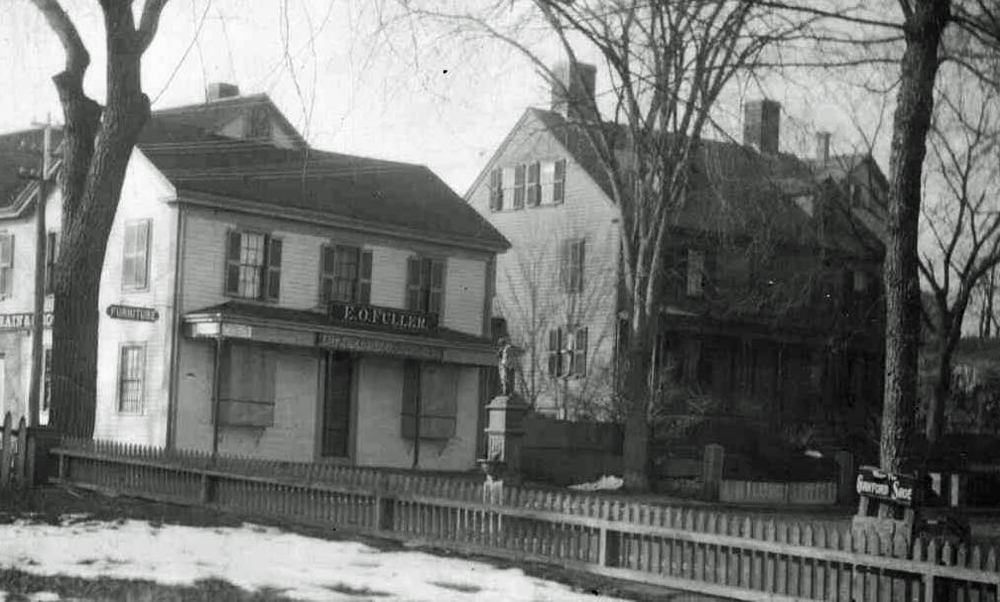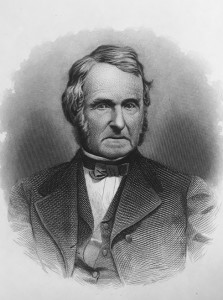True Tales from Canton’s Past: Moon Goddess
By George T. Comeau
The only photo that shows the fountain that stood at Washington and Neponset. (Courtesy of the Canton Historical Society)
We lose things all the time. I’m not talking about big things. Not the buildings, like the Crane School or the Canton Center train station, or even the old shovel shop. Recently we lost the historic waterfall and dam at Shepard’s Pond, and of course we are likely to lose the Canton Waterworks building while the Gridley School is threatened. And yet, I am thinking about all the small things — the items that get misplaced, stolen or destroyed. And there are so many examples. Once they slip from our collective memory, then they are gone forever.
Most recently the Cultural Resources Unit at the state Department of Transportation (MassDOT) has been planning to pursue a project to inventory the Massachusetts Bay Colony Tercentenary Signs that were placed throughout the commonwealth in 1930. In the preliminary stages of the project they are trying to identify if any of the missing signs are still around. In Canton, we had two designated as signs #197 and #198. Sadly, both are missing. In all, some 275 cast iron markers were erected in 1930 to mark the state’s 300th birthday. They commemorate “places which played a leading part in the history of the colony,” according to the official catalog issued at the time by the Massachusetts Bay Colony Tercentenary Commission.
The two we lost were both in Ponkapoag. Sign #197 was placed at the Ponkapoag School and marked the north line of the Ponkapaog Indian Plantation. It was stolen less than five years ago and has never been recovered. Sign #198 was in the traffic island at Route 138 in front of Crowell’s Market. That sign was lost when the island was engineered to allow for a new turning lane onto 138. We almost lost the famous Cape Cod sign at the intersection of Bolivar and Washington streets during the downtown revitalization. Less than 24 hours after it went missing, local historians found it tucked under a desk inside a work trailer. The sign was returned soon thereafter.
Then there are the larger items that have disappeared. At the foot of Blue Hill was an early 18th century milestone that went missing in the late 1970s or early 80s. Carved and massive, it may very well grace the backyard of a state worker’s landscape. There is a watering trough given by the Chapman family and purloined in the mid-century when Chapman Street was being widened and improved. Dating from 1896, it purportedly is in the yard of a selectman from a neighboring town. Efforts to have it returned — at our cost — have gone unheeded. Possession overrules ethics when it comes to antiquities and heritage.
But perhaps the most tantalizing of all lost objects is the fountain that once stood in the middle of the intersection of Washington and Neponset streets. It only appears in one photograph and the story is as fascinating as can be.
Clean public water was essential in the 19th century. So much of the town was polluted by the runoff of factories and raw sewage that ran into private wells. Having a clean and safe supply of water was a health mandate. And so numerous private citizens donated the actual fountains at their own costs. At this period in time, drinking fountains were all the vogue. Miss Caroline Downes purchased a trough made of Randolph granite for the corner of Bolivar and Pleasant streets. Elijah Morse had one at the corner of Lewis Street, and the Historical Society gave the Apostle Eliot trough at Randolph and Washington streets to the town. And at the town meeting of April 7, 1890, Article 24 was for a drinking fountain in Memorial Hall. And Elijah Morse agreed to give a fountain to the town provided the town pay for making the connections. The statue of the Infantryman at Memorial Hall was inside the vestibule and was in fact the fountain when it was originally presented to Canton.
What started it all was the 1889 gift from a very wealthy citizen by the name of Edwin Wentworth. Born here in 1805, Wentworth became a businessman at an early age. At age 17, he earned $900 as a merchant in Canton and Stoughton. Through his real-estate speculation, Wentworth was able to amass a fortune buying at auction and eventually managing several businesses, including a bakery and confectionary establishment. He held real estate in East Boston, Cambridge, Charlestown, Boston, South Braintree, and Stoughton. In Nantasket he owned four large properties, including the Wentworth House. In Canton alone he owned 25 boarding houses and was considered the largest real-estate owner in town.
Wentworth was well liked, fearless, outspoken and independent. It was said that “in all points at issue no one has ever had any difficulty in finding where he stood, either in politics, business, or town affairs.” His donation of a statue in the form of a watering fountain was appropriate for the man. The statue at the top of the fountain may well have been another story.
In September 1889, the headline of the local paper read, “It is Coming,” and the story went on to herald the news: “That there will be a drinking fountain at the junction of Washington and Neponset Street is an assured fact. Mr. Edwin Wentworth, with commendable generosity, has presented to the town such a fountain, at a cost of over $300. It has been ordered but it will not be ready to be placed in position for about three weeks. It will be of iron surmounted by a statue, with the total height of 9 feet, with drinking places for man, horses and dogs. A full description will be given later.”
The town made plans with great excitement: “F. J. Sawyer has been working on the foundation for the new fountain all the week. The large elm tree has been cut down and the streetlamp moved. The town will pay the expense of the foundation and making the connections with the water main. It may interest to readers to know that a fountain of the same kind of grace is on the beautiful grounds of the Astors, besides there being two in central park New York. It will be in running condition in about two weeks.” It would be another several weeks before the large crate arrived from New York City. The town waited.
By November 1, the statue was in place. The only description we have of the fountain reads as follows: “It is a handsome bronze structure resting on a granite base and surmounted by a statue. The four sides are finally ornamented with scroll work and designs. There are two places for dogs, a place for horses and a place for men to drink from. The fountain really makes a very imposing appearance and is an ornament to this part of the town.”
What was not reported was that the statue that graced the fountain was of the voluptuous Moon Goddess Diana. Legend tells us that the townspeople were not impressed. Having a scantily clad, full-bosomed goddess in the center of Washington Street was not the best influence for the children of Canton.
And there she stood. Only one photograph has been found that even remotely shows the statue. By 1925, it appears the town had come to part ways with Diana. On July 3, the selectmen ordered workers to dismantle the statue. The town’s highway department showed up with a truck and several chains, but Diana did not go easily. A crowd of men gathered, and the truck failed to dislodge the statue from its base as several heavy chains snapped under the weight. The men began digging down to free the pedestal from the ground. The town superintendent by the name of Roach ordered the men to dig. By late afternoon they had dug down six feet below the surface of the road and still failed to free the goddess from her perch.
In the meantime, William J. Murphy of Bailey Street took great umbrage at the loss of this curvaceous angel that had slaked the thirst of so many in town. A protest was lodged, and Murphy claimed that the site for the trough was selected by an act of the town meeting, and that “nothing except an act of the people in town meeting could undo it.” Murphy went on to argue that the people of Canton would have to rescind the action for the land to be used for something other than the fountain.
The brouhaha was pointless; the selectmen failed to heed the small and futile uprising and Murphy was brushed aside. Superintendent Roach was instructed to install a highway blinker at the site. The blinker was one that formerly graced the center of Washington and Sherman streets and had caused several car crashes when automobiles collided as a result of the warning beacon. On July 17, 1925, the newspaper observed, “The changing of the watering trough for the blinker incidentally remind one that the horse has been supplanted almost entirely by the automobile. Years ago, the thought of removing a watering trough would have brought out scores of criticisms. Only one protest was made when it was removed the other day.”
And with that, the Moon Goddess disappeared forever.
Short URL: https://www.thecantoncitizen.com/?p=38629











